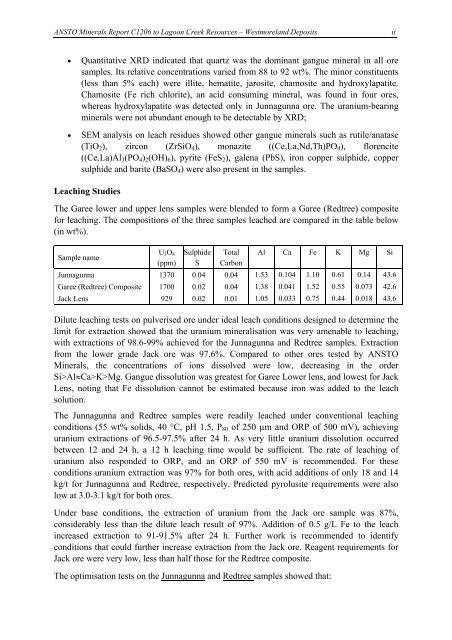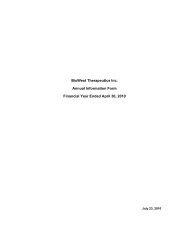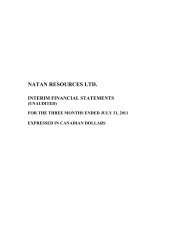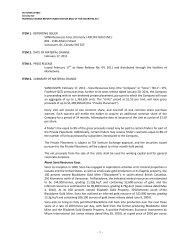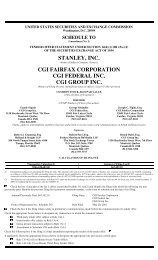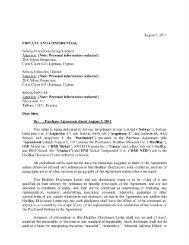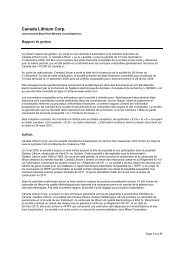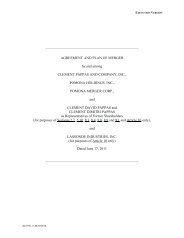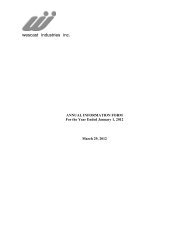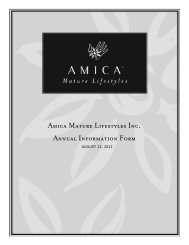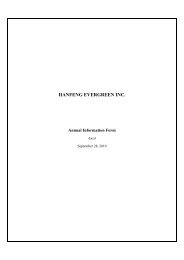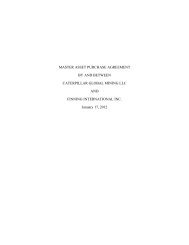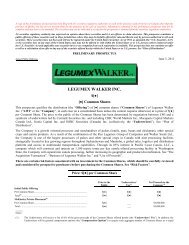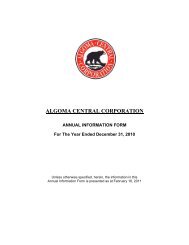Laterite Leach Tests
Laterite Leach Tests
Laterite Leach Tests
You also want an ePaper? Increase the reach of your titles
YUMPU automatically turns print PDFs into web optimized ePapers that Google loves.
ANSTO Minerals Report C1206 to Lagoon Creek Resources – Westmoreland Deposits ii<br />
• Quantitative XRD indicated that quartz was the dominant gangue mineral in all ore<br />
samples. Its relative concentrations varied from 88 to 92 wt%. The minor constituents<br />
(less than 5% each) were illite, hematite, jarosite, chamosite and hydroxylapatite.<br />
Chamosite (Fe rich chlorite), an acid consuming mineral, was found in four ores,<br />
whereas hydroxylapatite was detected only in Junnagunna ore. The uranium-bearing<br />
minerals were not abundant enough to be detectable by XRD;<br />
• SEM analysis on leach residues showed other gangue minerals such as rutile/anatase<br />
(TiO2), zircon (ZrSiO4), monazite ((Ce,La,Nd,Th)PO4), florencite<br />
((Ce,La)Al3(PO4)2(OH)6), pyrite (FeS2), galena (PbS), iron copper sulphide, copper<br />
sulphide and barite (BaSO4) were also present in the samples.<br />
<strong>Leach</strong>ing Studies<br />
The Garee lower and upper lens samples were blended to form a Garee (Redtree) composite<br />
for leaching. The compositions of the three samples leached are compared in the table below<br />
(in wt%).<br />
Sample name<br />
U3O8<br />
(ppm)<br />
Sulphide<br />
S<br />
Total<br />
Carbon<br />
Al Ca Fe K Mg Si<br />
Junnagunna 1370 0.04 0.04 1.53 0.104 1.10 0.61 0.14 43.6<br />
Garee (Redtree) Composite 1700 0.02 0.04 1.38 0.041 1.52 0.55 0.073 42.6<br />
Jack Lens 929 0.02 0.01 1.05 0.033 0.75 0.44 0.018 43.6<br />
Dilute leaching tests on pulverised ore under ideal leach conditions designed to determine the<br />
limit for extraction showed that the uranium mineralisation was very amenable to leaching,<br />
with extractions of 98.6-99% achieved for the Junnagunna and Redtree samples. Extraction<br />
from the lower grade Jack ore was 97.6%. Compared to other ores tested by ANSTO<br />
Minerals, the concentrations of ions dissolved were low, decreasing in the order<br />
Si>Al≈Ca>K>Mg. Gangue dissolution was greatest for Garee Lower lens, and lowest for Jack<br />
Lens, noting that Fe dissolution cannot be estimated because iron was added to the leach<br />
solution.<br />
The Junnagunna and Redtree samples were readily leached under conventional leaching<br />
conditions (55 wt% solids, 40 °C, pH 1.5, P80 of 250 µm and ORP of 500 mV), achieving<br />
uranium extractions of 96.5-97.5% after 24 h. As very little uranium dissolution occurred<br />
between 12 and 24 h, a 12 h leaching time would be sufficient. The rate of leaching of<br />
uranium also responded to ORP, and an ORP of 550 mV is recommended. For these<br />
conditions uranium extraction was 97% for both ores, with acid additions of only 18 and 14<br />
kg/t for Junnagunna and Redtree, respectively. Predicted pyrolusite requirements were also<br />
low at 3.0-3.1 kg/t for both ores.<br />
Under base conditions, the extraction of uranium from the Jack ore sample was 87%,<br />
considerably less than the dilute leach result of 97%. Addition of 0.5 g/L Fe to the leach<br />
increased extraction to 91-91.5% after 24 h. Further work is recommended to identify<br />
conditions that could further increase extraction from the Jack ore. Reagent requirements for<br />
Jack ore were very low, less than half those for the Redtree composite.<br />
The optimisation tests on the Junnagunna and Redtree samples showed that:


